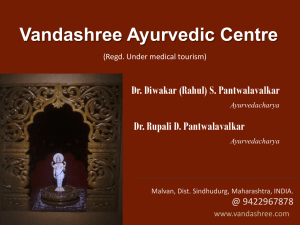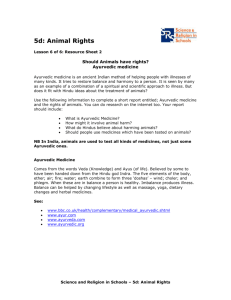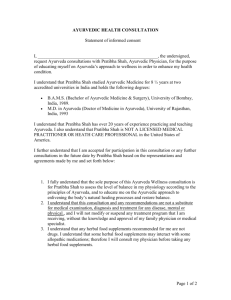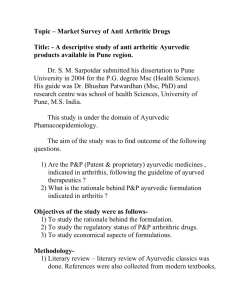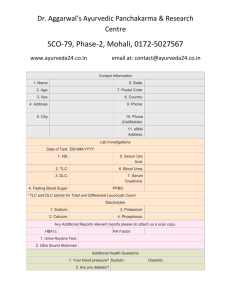Library Undergraduate Research Award Essay Ryan Prior
advertisement
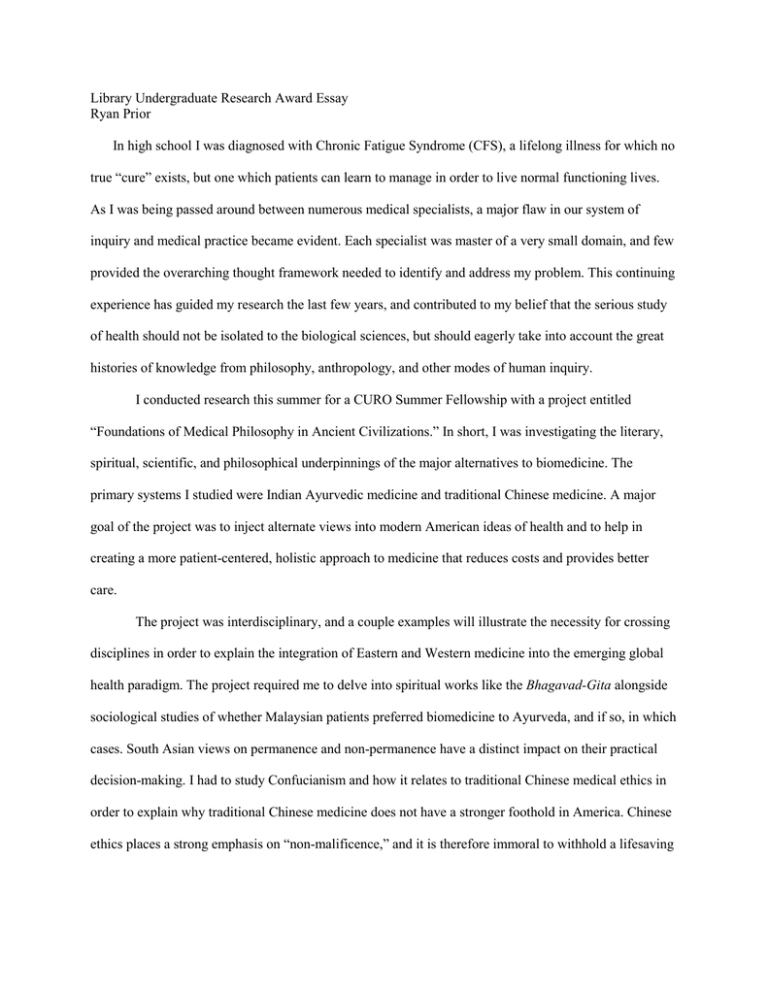
Library Undergraduate Research Award Essay Ryan Prior In high school I was diagnosed with Chronic Fatigue Syndrome (CFS), a lifelong illness for which no true “cure” exists, but one which patients can learn to manage in order to live normal functioning lives. As I was being passed around between numerous medical specialists, a major flaw in our system of inquiry and medical practice became evident. Each specialist was master of a very small domain, and few provided the overarching thought framework needed to identify and address my problem. This continuing experience has guided my research the last few years, and contributed to my belief that the serious study of health should not be isolated to the biological sciences, but should eagerly take into account the great histories of knowledge from philosophy, anthropology, and other modes of human inquiry. I conducted research this summer for a CURO Summer Fellowship with a project entitled “Foundations of Medical Philosophy in Ancient Civilizations.” In short, I was investigating the literary, spiritual, scientific, and philosophical underpinnings of the major alternatives to biomedicine. The primary systems I studied were Indian Ayurvedic medicine and traditional Chinese medicine. A major goal of the project was to inject alternate views into modern American ideas of health and to help in creating a more patient-centered, holistic approach to medicine that reduces costs and provides better care. The project was interdisciplinary, and a couple examples will illustrate the necessity for crossing disciplines in order to explain the integration of Eastern and Western medicine into the emerging global health paradigm. The project required me to delve into spiritual works like the Bhagavad-Gita alongside sociological studies of whether Malaysian patients preferred biomedicine to Ayurveda, and if so, in which cases. South Asian views on permanence and non-permanence have a distinct impact on their practical decision-making. I had to study Confucianism and how it relates to traditional Chinese medical ethics in order to explain why traditional Chinese medicine does not have a stronger foothold in America. Chinese ethics places a strong emphasis on “non-malificence,” and it is therefore immoral to withhold a lifesaving treatment. This presents a major obstacle to double blind placebo control studies in China. The scientific testing Westerners require for approving new treatments is unethical to Eastern practitioners. I met with the librarian Dr. Nan McMurry, who is herself an instructor in History of Medicine. We discussed the strengths and weaknesses of various GALILEO databases, some of which I had used before. The main databases I learned to use were MUSE, JSTOR, AltHealthWatch, and Academic Search Complete. MUSE and JSTOR were especially interesting for providing tiny fragments of articles, published sometimes 150 years ago, that shed light on historical views of Eastern medicine. AltHealthWatch was a very specific database relating to my project; it kept tabs on every recent research article published in fields related to “alternative medicine.” The most relevant research articles tended to be scientific trials of specific alternative treatments on specific symptoms or illnesses. Academic Search Complete produced perhaps my most relevant results in the broader sense. While AltHealthWatch focused primarily on nitty-gritty details of the scientific studies, the articles rarely contributed to a broader understanding of what the findings meant for ideas about health more generally. They might only say that acupuncture was “moderately effective” against alchoholism. However, Academic Search Complete yielded results from many “liberal arts” fields, particularly broad-based sociological studies on the effects of Ayurvedic medicine in numerous cities for numerous medical complaints. Also, there were long, well-written anthropology articles on specific practitioners in India that were extraordinarily useful. Commenting on Ayurvedic approaches that ranged from the philosophical to the scientific, these articles produced important commentary on the role of a healer in a society. Occasionally a broader, more philosophical look at the morality of one’s life might or might not prove as effective as specific diagnostic information relating to high blood pressure. Amidst this sea of information, I developed tools for determining the usefulness of research materials. The bibliography often betrayed an author’s lack of research. The Journal of Religion and Medicine was particularly guilty of this fault: in one study the author used only 14 citations, 7 of which came from the same source. His glaring lack of research showed in an article that lacked claims backed by serious logic. The Journal of Religion and Medicine published many articles marred by these same sub-par standards of research, and I learned to distrust what appeared in it. By contrast, articles of similar length published in the Journal of Medical Anthropology, Journal of Sociology and Medicine, and Journal of the American Medical Association might list up to sixty citations, with seldom more than a few being drawn from the same source. These more respectable journals produced articles that form the backbone of my own bibliography. I also learned to track specific researchers cited in others’ work. Those who had been the subject of multiple authors’ citations became the source of my Academic Search Complete queries. Ted Kaptchuk, the director of the Osher Institute at Harvard University, has authored or co-authored nearly a hundred research studies that seek to provide tangible evidence that acupuncture and other forms of Chinese medicine can treat ailments effectively. His brilliance comes not in discovering this fact (known for millennia in the Eastern world) but in finding specific ways to measure and record its effect. Because so many other researchers admired his work, I too learned to read it and love it. His now-classic work on Chinese medicine, The Web That Has No Weaver, was cited as often as Michel Foucault’s work The Birth of the Clinic. But Dr. McMurry’s greater contribution was not in introducing me to research sources and methodologies. More importantly, she introduced me to a bona fide community, alive at UGA, that believes in the same things I do. She and I also discussed resources in the community like the Athens Regional Medical Center’s Mind Body Institute and the new Medical College of Georgia campus in Athens. Professors there were delving into new approaches for teaching medical students, and Dr. Sujata Iyengar, a UGA English professor, was the liaison for various UGA humanities and social sciences professors in their advocacy for a liberal arts component in the medical curriculum. Dr. McMurry gave me a very useful list of local professors in anthropology, horticulture, speech communications, journalism and other fields who were presenting enriching new perspectives on medicine. My interdisciplinary research requires the kind of intense collaboration that the UGA-MGC Partnership provides. Unfortunately I didn’t consult Dr. McMurry and Dr. Iyengar until late in my twomonth fellowship, so I was not able to seek out each individual in the field of medical humanities. In an ideal situation, I would have conducted the consultation before I began the research, and begun seeking out the contacts she provided as early as possible. I spent too much time, anxious and worrying, laboring in isolation, and straining toward a poorly defined goal. If I’d had a support network in place before the research begun, my project could have been much more fruitful than it was. I would have had better direction than my own limited view of the subject at hand. For instance, the only professor I was able to meet with was Dr. Iyengar, and she broke down my research into three different categories: one would be to focus on public health, and possibly test alternative therapies in a scientific setting; another would be to focus on a particular culture’s interaction with medicine; and the last would be a straight literary analysis of novels or poems in their relation to illness and suffering. This professional academic’s analysis of the problem superseded my own judgment, and made my unwieldy project seem much more manageable. I could almost credit Dr. Iyengar with “rescuing” my project. My eventual final paper centered on analysis from a single medical perspective (Ayurveda) and applied these ancient philosophies to a single novel (Tolstoy’s Death of Ivan Ilych). I don’t think I could have settled on something as grounded as I did were it not for Dr. Iyengar’s insightful comments. She also volunteered to serve as my primary advisor for my senior thesis, should I decide to continue in this vein. The main lesson I learned from Dr. McMurry’s advice is that research is not an ascetic act, that cloistering myself away amid tomes and databases might lead to enlightenment eventually, but it was bound to produce a strong helping of loneliness and discontent. A well-balanced research project, on the other hand, would combine the necessary solo research with daily conferences with other experts. In short, I learned that good research is as much a political act as it is an intellectual one. What I knew was never quite as good as who I knew, and as a learning apprentice, I needed to seek the guidance of those well-versed in the fields at which I was looking. This is true for all young researchers, but especially true in my case, as my project required many different perspectives working together to produce the critique of Western academic analytics, and how their processes made better patient care hard to achieve. One basic, but very visceral example of the critique of Western academic structure is the work of Michel Foucault, a philosopher whose historical analysis of Western institutions was necessary for my project. Some of his works appear in the Main Library, but his Birth of the Clinic and Madness and Civilization are only available at the Science Library, a thirty minute round-trip walk from North Campus that wasted precious time and energy. Foucault’s work, like that of all great thinkers, spans the gap between literature, science, philosophy, and history, and becomes difficult to categorize, because he himself questioned “the order of things.” I point to this anecdote as a metaphor for the difficulties of intellectual inquiry my project was seeking to challenge: my project could not be contained in one building—it did not isolate itself to comparative literature’s Joe Brown Hall. It spanned the entire UGA campus and even hopped over to the medical campus. Because my project put me in a very immediate conflict with the existing order of things, another useful part of my conversation with Dr. McMurry simply centered on the development of the Library of Congress filing system used in the library, and learning why certain works were shelved on certain floors. Certain sections like computer science might have extremely long call numbers because these were nonexistent or undeveloped fields of study when the filing system was set up, and the boom in computer research since then has left little room for expansion within the limited space allotted to the field by the Library of Congress. The books therefore have many numbers after the decimal, because that is the only way to expand. In the end, I came to really appreciate the opportunity to conduct the research interview with a librarian. I learned a lot about the structure of a library, and consequently the structure of Western thought. But more importantly, I was introduced to the cast of characters that would make my research the success that it is. Works Cited Author Unknown. “‘Ayurvedic’ Medicine.” Letter. British Medical Journal. 1.1694, 17 Jun 1893, p. 1282. J-STOR. 14 Jun 2010. Ahluwalia, Aneeta. “Sociology of Medicine in India: An Approach.” Economic and Political Weekly. 2.22 (3 Jun 1967): 1007-1012. J-STOR. 14 Jun 2010. Editors, et al. “J-AIM—A Renaissance for Ayurveda.” Journal of Ayurvedic and Integrative Medicine. 1.1 (2010). 1-2. GALILEO. 21 Jun 2010. Foucault, Michel. Birth of the Clinic. New York: Random House, 1994. Print. Glynn, Judith R., and Timothy D. Heymann. “Factors that Influence Patients in Sri Lanka In Their Choice Between Ayurvedic and Western Medicine.” British Medical Journal. 291. 6493 17 Aug, 1985. Pp. 470-472. J-STOR. 14 Jun 2010. Jain, Nick. "Nephroptosis: EMedicine Urology." EMedicine - Medical Reference. 7 Jan. 2010. Web. 10 Aug. 2010. <http://emedicine.medscape.com/article/1458935overview>. Langford, Jean. “Ayurvedic Interiors: Person, Space, and Episteme in Three Medical Practices. Cultural Anthropology. 10.3 (Aug., 1995): 330-366. J-STOR. 14 Jun 2010. Larson, Gerald James. “Ayurveda and the Hindu Philosophical Systems.” Philosophy of East and West 37.3 (1987): 245-259. Print. 9 Aug 2010. Leslie, C.M. “The Rhetoric of the Ayurvedic Revival in Modern India.” Man. Vol. 63 May, 1963. 72-73. J-STOR. 14 Jun 2010. Patwardhan, Bhushan, et al. “Ayurveda and Traditional Chinese Medicine: A Comparative Overview.” Evidence-based Complementary and Alternative Medicine. 2.4 (2005) 465-473. GALILEO. 26 Jun 2010. Reddy, Sita. “Medicine in America: The Ayurvedic Case.” Annals of the American Academy of Political and Social Science. Vol. 583, Global Perspectives on Complementary and Alternative Medicine (Sep. 2002): 97-121. J-STOR. 14 Jun 2010. “The Lord’s Song (Bhagavad Gita).” Wisdom of China and India. Ed. Lin Yutang. New York: Random House, 1942. 57-114. Print. Tolstoy, Leo. “Death of Ivan Ilych.” Great Short Works of Leo Tolstoy. Ed. John Bayley . New York: HarperCollins, 2004. 245-302. Print. Willis, R. Wayne. “Positive Paradigm Shifts in Health Care.” Journal of Religion and Health 39.4 (Winter 2000) 355-364. Print. ABSTRACT As the humanities provide us with a rich reservoir of wisdom on what it means to be human and to live a good life, viewing the body and illness from a perspective beyond the merely biochemical can yield not only better doctors but also a better society. Throughout history different civilizations have had widely varying medical philosophies, stemming from their religion and philosophy as much as their art and literature. Studying notions of sickness and death in Western literature, we can find yearnings for a more humane medicine, one that realizes that healing must be as spiritual and emotional as it is physical. In Tolstoy’s meditations on sickness and death in Death of Ivan Ilyich, we find a character whose attempts to find healing through relationships are condemned by a medical doctor as “foolishness.” Yet Ayurvedic practitioners in India, valuing community, inquire about a patient’s social well-being in the initial consultation. Ivan Ilyich comes to realize that his moral failings, family relations, and bitterness are as much to blame for his illness as his actual physical make-up. His internal monologues seem as if taken from sociological and anthropological case studies of Ayurvedic practitioners, healers who might tell victims of anxiety not to take Xanax, but to gain perspective by spending time with the poor. In comparing Ayurvedic case studies with passages from Tolstoy’s text, this study will construct an Ayurvedic “treatment” for Ivan Ilych, one that aligns with the character’s own judgments of himself, a philosophical cure that succeeds where science could not.
